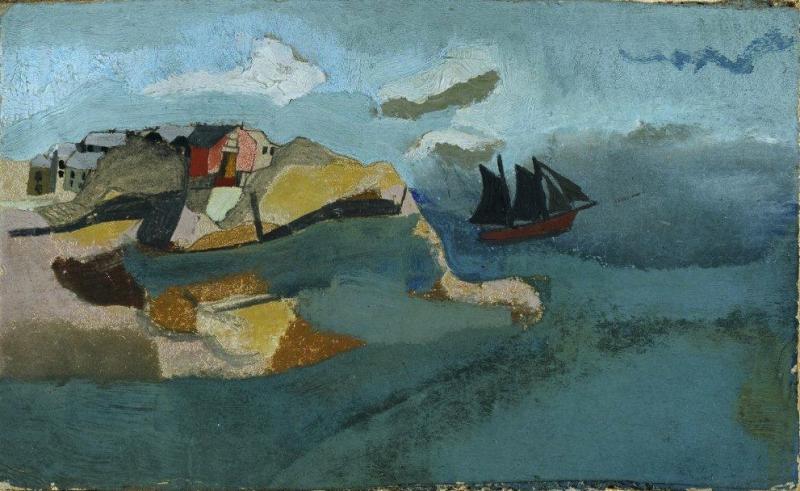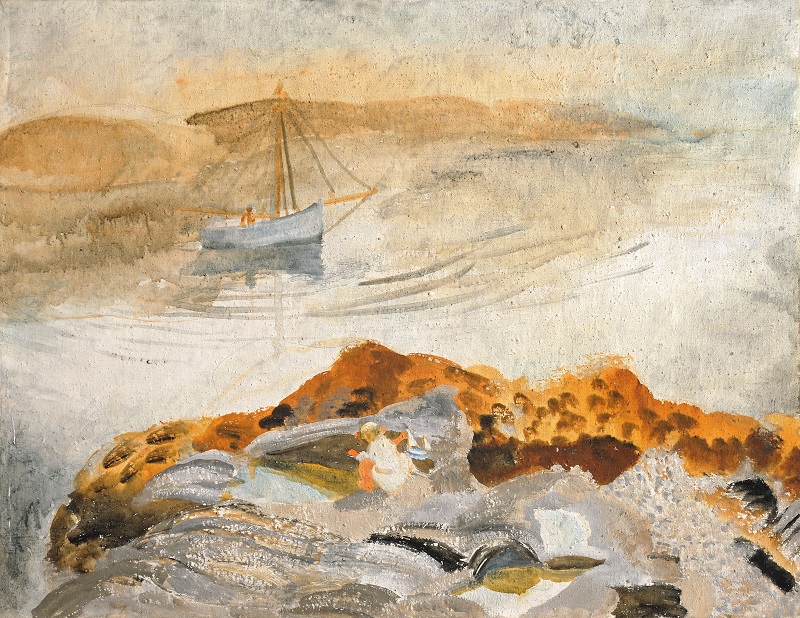Art and Life: Ben and Winifred Nicholson, Dulwich Picture Gallery | reviews, news & interviews
Art and Life: Ben and Winifred Nicholson, Dulwich Picture Gallery
Art and Life: Ben and Winifred Nicholson, Dulwich Picture Gallery
Intense personal relationships fuelled the creativity at the heart of British modernism

At the risk of sounding crass, I can’t help feeling that had Winifred Nicholson painted fewer flowers she might be better represented in the annals of art history. Of course, being a woman hasn’t helped, but as a woman flower painter she was ever destined for the footnotes.
Next to the white reliefs and austere abstract paintings that have secured her husband's reputation in the vanguard of British modernism, Winifred’s paintings are, superficially at least, steadfastly domestic, the motif of potted flowers persisting through her experiments with abstraction.
Far from following a trajectory of simplification, Ben’s exploration of colour intensified
After their marriage in 1920 the Nicholsons lived together for a decade or so, and it is this fertile period at the start of their careers that the exhibition explores. The painters Christopher Wood and Alfred Wallis, and the potter William Staite Murray, who also feature, were firm friends with the Nicholsons, and examples of their work show the extent to which they too were engaged in mutually rewarding creative relationships.
 The Nicholsons often worked from the same subjects, and included here are several instances of landscapes painted from the same viewpoint. A cross fertilization of ideas extended far beyond sharing a view or a prop, however, and the pairing of Ben Nicholson’s 1924 (first abstract painting, Chelsea) with Winifred’s King’s Road, Chelsea, 1925, is an example of the subtle but complex nature of their exchanges. The two paintings share a distinctive colour range, and the “magenta pink” favoured by Winifred throughout her career dominates her husband's overlapping blocks of colour, the delicate blues and greys of Winifred’s receding cityscape and the brown of the brickwork further echoing Ben’s palette. Winifred’s view from their studio window, built from simple blocks of colour, nods to the construction of her husband’s painting, while his picture seems equally indebted to hers, elevating colour over other concerns.
The Nicholsons often worked from the same subjects, and included here are several instances of landscapes painted from the same viewpoint. A cross fertilization of ideas extended far beyond sharing a view or a prop, however, and the pairing of Ben Nicholson’s 1924 (first abstract painting, Chelsea) with Winifred’s King’s Road, Chelsea, 1925, is an example of the subtle but complex nature of their exchanges. The two paintings share a distinctive colour range, and the “magenta pink” favoured by Winifred throughout her career dominates her husband's overlapping blocks of colour, the delicate blues and greys of Winifred’s receding cityscape and the brown of the brickwork further echoing Ben’s palette. Winifred’s view from their studio window, built from simple blocks of colour, nods to the construction of her husband’s painting, while his picture seems equally indebted to hers, elevating colour over other concerns.
The platitude that Ben was concerned with form and Winifred with colour is put under considerable strain by such insightful comparisons, and the exhibition mounts several challenges to our perceptions of these artists. Pictures from the Nicholsons’ time in Cumberland, and subsequently in St Ives, Cornwall, show that far from following a trajectory of simplification, culminating in the wholesale abandonment of colour in his white reliefs, Ben’s exploration of colour intensified in the period around 1930. In c. 1930 (Birch Craig Summer), he swapped his customary subdued palette for bright, light greens and blues that evoke the warmth and stillness of the scene, invoking Winifred’s use of colour at this time.
For both Ben and Winifred, and indeed Wood, the experience of visiting St Ives had an enormous impact, with Ben Nicholson’s c.1930 (Cornish port) (main picture) and Winifred’s Summer, 1928, introducing entirely new colour ranges that reflect the almost exotic contrast between this southerly location and their Cumberland home. Of the three painters, Winifred’s response is the most assured and sophisticated; the influence of her expressive brushwork and approach to colour can be seen in the work of all those around her, and in Anemones in a Cornish Window, 1930, (pictured above right) Wood pays homage to one of Winifred’s most enduring themes.
 It was while staying in Cornwall that the Nicholsons met the marine painter Alfred Wallis, beginning a friendship that would have a radical effect on all parties. Completely self-taught, Wallis seemed to embody an approach “as unselfconscious, as genuine, as direct and vital as we find in most primitive art” and Ben emulated his simple, almost childlike style. Winifred in particular responded to Wallis’s instinctive capacity to convey movement, which seems to have chimed with her own talent for imbuing her paintings with energy and vigour. To Winifred, Wallis “painted with the imagination of a poet and the restraint of colour and sense of movement of a master,” and these qualities are evident in her raw, elemental paintings, such as Seascape with Two Boats, c.1932 (pictured above left). For Wallis, the meeting with the Nicholsons was particularly fortuitous, as he found himself suddenly in demand, with art dealers clamouring to buy his work.
It was while staying in Cornwall that the Nicholsons met the marine painter Alfred Wallis, beginning a friendship that would have a radical effect on all parties. Completely self-taught, Wallis seemed to embody an approach “as unselfconscious, as genuine, as direct and vital as we find in most primitive art” and Ben emulated his simple, almost childlike style. Winifred in particular responded to Wallis’s instinctive capacity to convey movement, which seems to have chimed with her own talent for imbuing her paintings with energy and vigour. To Winifred, Wallis “painted with the imagination of a poet and the restraint of colour and sense of movement of a master,” and these qualities are evident in her raw, elemental paintings, such as Seascape with Two Boats, c.1932 (pictured above left). For Wallis, the meeting with the Nicholsons was particularly fortuitous, as he found himself suddenly in demand, with art dealers clamouring to buy his work.
As a piece of curation, this exhibition is bold and exciting, the thoughtful hang allowing genuinely original insights about the nature of the Nicholsons’ creative partnership, but also raising questions about the very nature of creative endeavour. The brilliance of Winifred's output is quite subtly brought to the fore, while the focus on such a short but formative period invites us to reflect on the later work of Ben, in particular, with fresh eyes and perhaps even a new perspective on his legacy.
Explore topics
Share this article
The future of Arts Journalism
You can stop theartsdesk.com closing!
We urgently need financing to survive. Our fundraising drive has thus far raised £49,000 but we need to reach £100,000 or we will be forced to close. Please contribute here: https://gofund.me/c3f6033d
And if you can forward this information to anyone who might assist, we’d be grateful.

Subscribe to theartsdesk.com
Thank you for continuing to read our work on theartsdesk.com. For unlimited access to every article in its entirety, including our archive of more than 15,000 pieces, we're asking for £5 per month or £40 per year. We feel it's a very good deal, and hope you do too.
To take a subscription now simply click here.
And if you're looking for that extra gift for a friend or family member, why not treat them to a theartsdesk.com gift subscription?
more Visual arts
 'We are bowled over!' Thank you for your messages of love and support
Much-appreciated words of commendation from readers and the cultural community
'We are bowled over!' Thank you for your messages of love and support
Much-appreciated words of commendation from readers and the cultural community
 Folkestone Triennial 2025 - landscape, seascape, art lovers' escape
Locally rooted festival brings home many but not all global concerns
Folkestone Triennial 2025 - landscape, seascape, art lovers' escape
Locally rooted festival brings home many but not all global concerns
 Sir Brian Clarke (1953-2025) - a personal tribute
Remembering an artist with a gift for the transcendent
Sir Brian Clarke (1953-2025) - a personal tribute
Remembering an artist with a gift for the transcendent
 Emily Kam Kngwarray, Tate Modern review - glimpses of another world
Pictures that are an affirmation of belonging
Emily Kam Kngwarray, Tate Modern review - glimpses of another world
Pictures that are an affirmation of belonging
 Kiefer / Van Gogh, Royal Academy review - a pairing of opposites
Small scale intensity meets large scale melodrama
Kiefer / Van Gogh, Royal Academy review - a pairing of opposites
Small scale intensity meets large scale melodrama
 Jenny Saville: The Anatomy of Painting, National Portrait Gallery review - a protégé losing her way
A brilliant painter in search of a worthwhile subject
Jenny Saville: The Anatomy of Painting, National Portrait Gallery review - a protégé losing her way
A brilliant painter in search of a worthwhile subject
 Abstract Erotic, Courtauld Gallery review - sculpture that is sensuous, funny and subversive
Testing the boundaries of good taste, and winning
Abstract Erotic, Courtauld Gallery review - sculpture that is sensuous, funny and subversive
Testing the boundaries of good taste, and winning
 Edward Burra, Tate Britain review - watercolour made mainstream
Social satire with a nasty bite
Edward Burra, Tate Britain review - watercolour made mainstream
Social satire with a nasty bite
 Ithell Colquhoun, Tate Britain review - revelations of a weird and wonderful world
Emanations from the unconscious
Ithell Colquhoun, Tate Britain review - revelations of a weird and wonderful world
Emanations from the unconscious
 Rachel Jones: Gated Canyons, Dulwich Picture Gallery review - teeth with a real bite
Mouths have never looked so good
Rachel Jones: Gated Canyons, Dulwich Picture Gallery review - teeth with a real bite
Mouths have never looked so good
 Yoshitomo Nara, Hayward Gallery review - sickeningly cute kids
How to make millions out of kitsch
Yoshitomo Nara, Hayward Gallery review - sickeningly cute kids
How to make millions out of kitsch
 Hamad Butt: Apprehensions, Whitechapel Gallery review - cool, calm and potentially lethal
The YBA who didn’t have time to become a household name
Hamad Butt: Apprehensions, Whitechapel Gallery review - cool, calm and potentially lethal
The YBA who didn’t have time to become a household name

Add comment